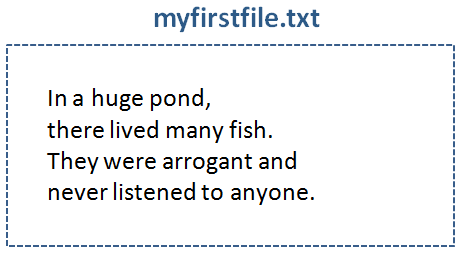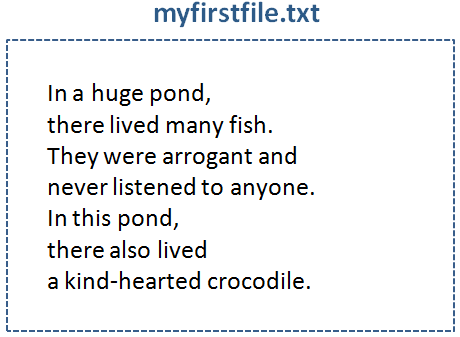PYTHON - WRITE TO FILE
So in the previous tutorial, we have created file 'myfirstfile.txt' using the 'open( )' Function.
myfile = open("myfirstfile.txt", "xt")
Now, let us see, how can we write something to the file.
There are two modes of writing to a File :
-
"w" - Write Mode - Write mode is used to write something to the file. It overwrites the contents of the file. And if the file is not present, it creates a new file.
-
"a" - Append Mode - Append mode is used to write something at the end of the file. And if the file is not present, it creates a new file.
So, we have created the file, 'myfirstfile.txt'. Now, let us write the below paragraph to the file.
In a huge pond,
there lived many fish.
They were arrogant and
never listened to anyone.
Example :
myfile = open("myfirstfile.txt", "w")
para = """In a huge pond,
there lived many fish.
They were arrogant and
never listened to anyone."""
myfile.write(para)
myfile.close()
Output :
Now, if you open the File, 'myfirstfile.txt', you can find the below contents,
-
So, what we have done in the above example is, opened the file in Write Mode(i.e. 'w').
myfile = open("myfirstfile.txt", "w")
We haven't specified the 'Text Mode' (i.e. 't') because it is the default mode.
-
Then we have initialise the paragraph in a variable, 'para' using triple quotes.
para = """In a huge pond,
there lived many fish.
They were arrogant and
never listened to anyone."""
-
After that we have used the 'write( )' Function to write the paragraph to the file.
myfile.write(para)
-
Finally, we close the file using the 'close( )' Function.
myfile.close( )
Now, let us say, we want to add three more lines to the above paragraph.
In this pond,
there also lived
a kind-hearted crocodile.
Example :
myfile = open("myfirstfile.txt", "a")
para = """\nIn this pond,
there also lived
a kind-hearted crocodile."""
myfile.write(para)
myfile.close()
Output :
Now, if you open the File, 'myfirstfile.txt', you can find the below contents,
-
So, what we have done in the above example is, opened the file in Append Mode(i.e. 'a').
myfile = open("myfirstfile.txt", "a")
We haven't specified the 'Text Mode' (i.e. 't') because it is the default mode.
-
Then we have initialised the paragraph in a variable, 'para' using triple quotes. So that we could append those three more lines to the existing File.
para = """\nIn this pond,
there also lived
a kind-hearted crocodile."""
We have put the escape character '\n'. So that the new lines are added to the next line of the existing contents of the file.
-
After that we have used the 'write( )' Function to write the paragraph to the file.
myfile.write(para)
-
Finally, we close the file using the 'close( )' Function.
myfile.close( )
Next, we will see, how can we read the above file in Python.



